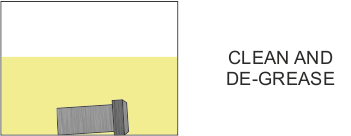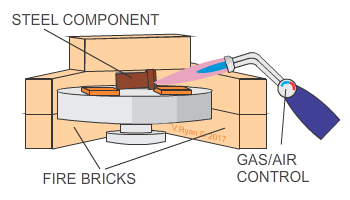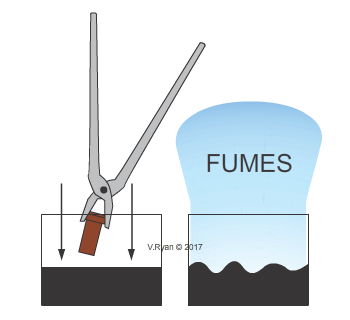| CLICK HERE FOR INDEX PAGE |
| |
| TRADITIONAL OIL BLACKING OF STEEL |
| V.Ryan © 2018 |
| |
| DO NOT USE THIS TECHNIQUE UNLESS YOU ARE COMPETENT IN HEAT TREATMENT PROCESSES |
| |
| PDF FILE - CLICK HERE FOR PRINTABLE WORKSHEET |
| |
| When manufacturing components from steel, corrosion to the surface will always be a problem, especially if the product / component is in contact with moisture, as carried in the atmosphere. One of the most cost effective ways of preventing tarnishing / corrosion to the surface of steel, is to ‘Oil Black’. This can be achieved on a small scale in schools, although safety precautions must be taken. |
| |
| 1. Prepare the surface of the component, through the use of hand tools, such as files and the use of wet and dry paper / emery cloth. OR prepare the surface with a machined finish, through the use of a lathe, miller, surface grinder etc.... |
|
 |
| |
|
|
| |
| 2. Ensure that all surfaces are clean of dirt and grease. Wipe the component clean and even soak it in a de-greasing solution. The wash the component in clean water and allow to dry. |
|
 |
| |
|
|
| 3. Heat the component to ‘red’ heat, on a brazing hearth. |
|
 |
| |
|
|
| |
4. Using tongs and wearing protective clothing, drop the ‘red’ hot component into a steel container of old engine oil. There must be extraction, as found above a brazing hearth or ceramic chip forge, due to the large volumes of fumes.
The old engine oil will bubble, due to the heat given off by the component.
5. Remove the component, after it has cooled sufficiently, using tongs and place it on a metal plate or an anvil and allow to cool fully.
|
|
 |
| |
|
|
The resulting finish, will be dark satin in colour and will be corrosion resistant.
The carbon found in old engine oil, penetrates the surface of the steel, resulting in an interesting and functional finish. |
|
 |
| |
|
|
| |
| SAMPLE OIL BLACKED COMPONENTS |
 |
| |
| CLICK HERE FOR RESISTANT MATERIALS INDEX PAGE |
| |
|
| |
|





